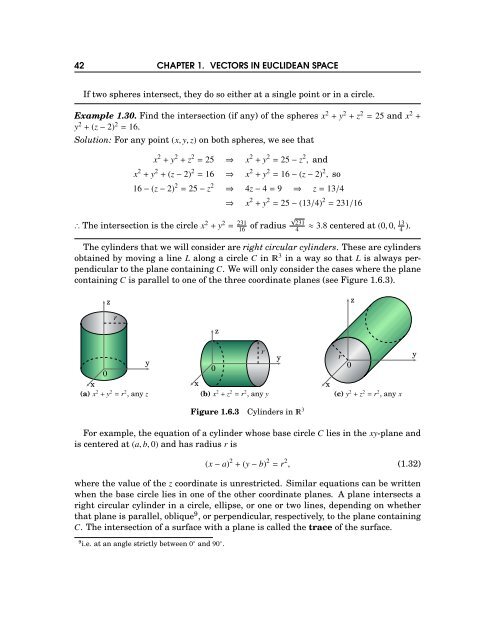Michael Corral: Vector Calculus
Michael Corral: Vector Calculus
Michael Corral: Vector Calculus
Create successful ePaper yourself
Turn your PDF publications into a flip-book with our unique Google optimized e-Paper software.
42 CHAPTER 1. VECTORS IN EUCLIDEAN SPACE<br />
If two spheres intersect, they do so either at a single point or in a circle.<br />
Example 1.30. Find the intersection (if any) of the spheres x 2 +y 2 +z 2 = 25 and x 2 +<br />
y 2 +(z−2) 2 = 16.<br />
Solution: For any point (x,y,z) on both spheres, we see that<br />
x 2 +y 2 +z 2 = 25 ⇒ x 2 +y 2 = 25−z 2 , and<br />
x 2 +y 2 +(z−2) 2 = 16 ⇒ x 2 +y 2 = 16−(z−2) 2 , so<br />
16−(z−2) 2 = 25−z 2<br />
⇒ 4z−4=9 ⇒ z=13/4<br />
⇒ x 2 +y 2 = 25−(13/4) 2 = 231/16<br />
∴ The intersection is the circle x 2 +y 2 = 231<br />
16 of radius √<br />
231<br />
4<br />
≈ 3.8 centered at (0,0, 13 4 ).<br />
The cylinders that we will consider are right circular cylinders. These are cylinders<br />
obtained by moving a line L along a circle C in 3 in a way so that L is always perpendicular<br />
to the plane containingC. We will only consider the cases where the plane<br />
containing C is parallel to one of the three coordinate planes (see Figure 1.6.3).<br />
z<br />
z<br />
r<br />
z<br />
y<br />
0<br />
x<br />
(a) x 2 +y 2 = r 2 , any z<br />
r<br />
0<br />
x<br />
(b) x 2 +z 2 = r 2 , any y<br />
y<br />
x<br />
r<br />
0<br />
(c) y 2 +z 2 = r 2 , any x<br />
y<br />
Figure 1.6.3 Cylinders in 3<br />
For example, the equation of a cylinder whose base circle C lies in the xy-plane and<br />
is centered at (a,b,0) and has radius r is<br />
(x−a) 2 +(y−b) 2 = r 2 , (1.32)<br />
where the value of the z coordinate is unrestricted. Similar equations can be written<br />
when the base circle lies in one of the other coordinate planes. A plane intersects a<br />
right circular cylinder in a circle, ellipse, or one or two lines, depending on whether<br />
that plane is parallel, oblique 9 , or perpendicular, respectively, to the plane containing<br />
C. The intersection of a surface with a plane is called the trace of the surface.<br />
9 i.e. at an angle strictly between 0 ◦ and 90 ◦ .








